初中英语微型课题研究
初中英语老师教研课题(3篇)
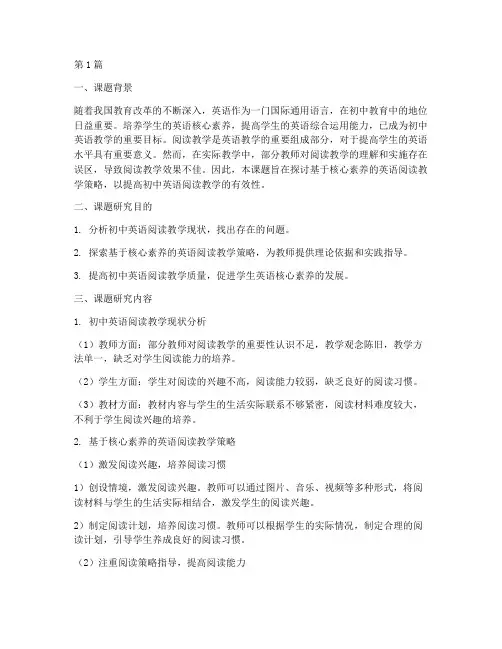
第1篇一、课题背景随着我国教育改革的不断深入,英语作为一门国际通用语言,在初中教育中的地位日益重要。
培养学生的英语核心素养,提高学生的英语综合运用能力,已成为初中英语教学的重要目标。
阅读教学是英语教学的重要组成部分,对于提高学生的英语水平具有重要意义。
然而,在实际教学中,部分教师对阅读教学的理解和实施存在误区,导致阅读教学效果不佳。
因此,本课题旨在探讨基于核心素养的英语阅读教学策略,以提高初中英语阅读教学的有效性。
二、课题研究目的1. 分析初中英语阅读教学现状,找出存在的问题。
2. 探索基于核心素养的英语阅读教学策略,为教师提供理论依据和实践指导。
3. 提高初中英语阅读教学质量,促进学生英语核心素养的发展。
三、课题研究内容1. 初中英语阅读教学现状分析(1)教师方面:部分教师对阅读教学的重要性认识不足,教学观念陈旧,教学方法单一,缺乏对学生阅读能力的培养。
(2)学生方面:学生对阅读的兴趣不高,阅读能力较弱,缺乏良好的阅读习惯。
(3)教材方面:教材内容与学生的生活实际联系不够紧密,阅读材料难度较大,不利于学生阅读兴趣的培养。
2. 基于核心素养的英语阅读教学策略(1)激发阅读兴趣,培养阅读习惯1)创设情境,激发阅读兴趣。
教师可以通过图片、音乐、视频等多种形式,将阅读材料与学生的生活实际相结合,激发学生的阅读兴趣。
2)制定阅读计划,培养阅读习惯。
教师可以根据学生的实际情况,制定合理的阅读计划,引导学生养成良好的阅读习惯。
(2)注重阅读策略指导,提高阅读能力1)教授阅读技巧。
教师应教授学生阅读技巧,如略读、寻读、扫读等,帮助学生提高阅读速度和理解能力。
2)培养学生的批判性思维。
教师应引导学生对阅读材料进行思考和分析,提高学生的批判性思维能力。
(3)加强阅读活动设计,提高阅读效果1)小组合作阅读。
教师可以组织学生进行小组合作阅读,培养学生的合作意识和团队精神。
2)角色扮演。
教师可以引导学生进行角色扮演,提高学生的口语表达能力和交际能力。
内黄初中英语微教研(3篇)
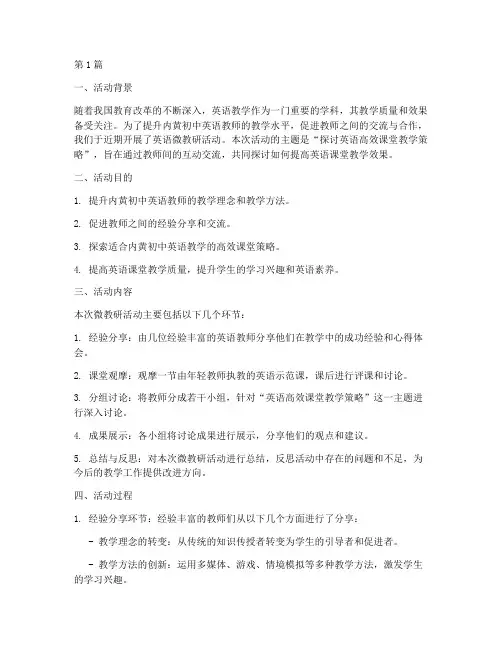
第1篇一、活动背景随着我国教育改革的不断深入,英语教学作为一门重要的学科,其教学质量和效果备受关注。
为了提升内黄初中英语教师的教学水平,促进教师之间的交流与合作,我们于近期开展了英语微教研活动。
本次活动的主题是“探讨英语高效课堂教学策略”,旨在通过教师间的互动交流,共同探讨如何提高英语课堂教学效果。
二、活动目的1. 提升内黄初中英语教师的教学理念和教学方法。
2. 促进教师之间的经验分享和交流。
3. 探索适合内黄初中英语教学的高效课堂策略。
4. 提高英语课堂教学质量,提升学生的学习兴趣和英语素养。
三、活动内容本次微教研活动主要包括以下几个环节:1. 经验分享:由几位经验丰富的英语教师分享他们在教学中的成功经验和心得体会。
2. 课堂观摩:观摩一节由年轻教师执教的英语示范课,课后进行评课和讨论。
3. 分组讨论:将教师分成若干小组,针对“英语高效课堂教学策略”这一主题进行深入讨论。
4. 成果展示:各小组将讨论成果进行展示,分享他们的观点和建议。
5. 总结与反思:对本次微教研活动进行总结,反思活动中存在的问题和不足,为今后的教学工作提供改进方向。
四、活动过程1. 经验分享环节:经验丰富的教师们从以下几个方面进行了分享:- 教学理念的转变:从传统的知识传授者转变为学生的引导者和促进者。
- 教学方法的创新:运用多媒体、游戏、情境模拟等多种教学方法,激发学生的学习兴趣。
- 学生评价体系的改革:关注学生的个体差异,实施多元化的评价方式。
2. 课堂观摩环节:年轻教师通过创设真实的语言环境,引导学生积极参与课堂活动,充分展示了高效课堂教学的魅力。
3. 分组讨论环节:各小组围绕以下问题进行讨论:- 如何在课堂教学中激发学生的学习兴趣?- 如何有效地运用多种教学方法?- 如何关注学生的个体差异,实施差异化教学?- 如何提高英语课堂的互动性和参与度?4. 成果展示环节:各小组分别从以下几个方面展示了他们的讨论成果:- 制定了一套适用于内黄初中英语教学的高效课堂策略。
初中英语微教研课题(3篇)
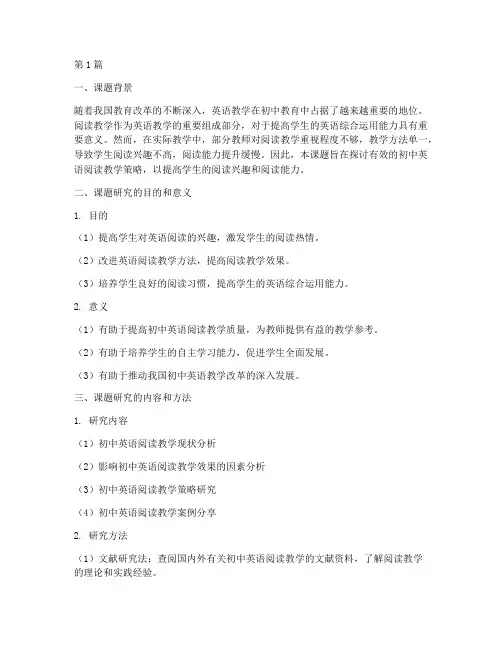
第1篇一、课题背景随着我国教育改革的不断深入,英语教学在初中教育中占据了越来越重要的地位。
阅读教学作为英语教学的重要组成部分,对于提高学生的英语综合运用能力具有重要意义。
然而,在实际教学中,部分教师对阅读教学重视程度不够,教学方法单一,导致学生阅读兴趣不高,阅读能力提升缓慢。
因此,本课题旨在探讨有效的初中英语阅读教学策略,以提高学生的阅读兴趣和阅读能力。
二、课题研究的目的和意义1. 目的(1)提高学生对英语阅读的兴趣,激发学生的阅读热情。
(2)改进英语阅读教学方法,提高阅读教学效果。
(3)培养学生良好的阅读习惯,提高学生的英语综合运用能力。
2. 意义(1)有助于提高初中英语阅读教学质量,为教师提供有益的教学参考。
(2)有助于培养学生的自主学习能力,促进学生全面发展。
(3)有助于推动我国初中英语教学改革的深入发展。
三、课题研究的内容和方法1. 研究内容(1)初中英语阅读教学现状分析(2)影响初中英语阅读教学效果的因素分析(3)初中英语阅读教学策略研究(4)初中英语阅读教学案例分享2. 研究方法(1)文献研究法:查阅国内外有关初中英语阅读教学的文献资料,了解阅读教学的理论和实践经验。
(2)调查研究法:通过问卷调查、访谈等方式,了解学生、教师对阅读教学的看法和建议。
(3)案例分析法:选取具有代表性的阅读教学案例,分析其成功经验和不足之处。
(4)行动研究法:在教学中尝试实施新的阅读教学策略,观察和评估其效果。
四、预期成果1. 形成一套适用于初中英语阅读教学的策略体系。
2. 提高教师对阅读教学的认识,丰富教师的教学经验。
3. 培养学生的阅读兴趣,提高学生的阅读能力。
4. 为我国初中英语阅读教学改革提供有益的借鉴。
五、研究步骤1. 准备阶段(2023年1月-2月)(1)收集和整理相关文献资料。
(2)制定研究方案和实施计划。
2. 实施阶段(2023年3月-10月)(1)进行问卷调查和访谈,了解学生、教师对阅读教学的看法和建议。
英语微型课题研究
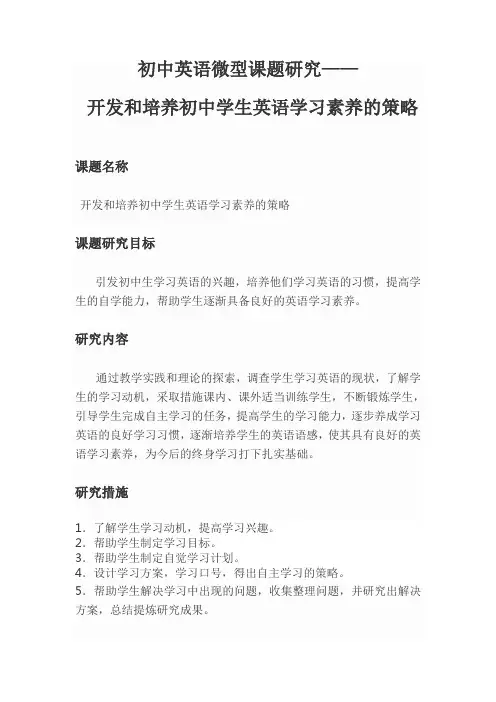
初中英语微型课题研究——开发和培养初中学生英语学习素养的策略课题名称开发和培养初中学生英语学习素养的策略课题研究目标引发初中生学习英语的兴趣,培养他们学习英语的习惯,提高学生的自学能力,帮助学生逐渐具备良好的英语学习素养。
研究内容通过教学实践和理论的探索,调查学生学习英语的现状,了解学生的学习动机,采取措施课内、课外适当训练学生,不断锻炼学生,引导学生完成自主学习的任务,提高学生的学习能力,逐步养成学习英语的良好学习习惯,逐渐培养学生的英语语感,使其具有良好的英语学习素养,为今后的终身学习打下扎实基础。
研究措施1.了解学生学习动机,提高学习兴趣。
2.帮助学生制定学习目标。
3.帮助学生制定自觉学习计划。
4.设计学习方案,学习口号,得出自主学习的策略。
5.帮助学生解决学习中出现的问题,收集整理问题,并研究出解决方案,总结提炼研究成果。
研究方法1.文献资料法;2.调查法;3.个案研究法;4.行动研究法。
预设成果研究论文:主要阐述初中学生英语自主学习的能力培养和初中生英语自主学习素养的培养的策略研究。
研究时间:2013.3——2013.8研究人员:李瑛初中英语微型课题研究——开发和培养初中学生英语学习素养的策略一、研究方案的背景当前社会发展需要学生熟练掌握英语,那种灌输知识的教学方法已不适应时代的需要,而学生的学习任务繁重,学生对于难度较高的《牛津初中英语》难以顺利熟练掌握英语。
在教学过程中老师往往注重英语知识的传授,而不是让学生自觉、主动地吸收英语知识和运用英语。
学生的学习方法,急需老师帮助他们改进,而且帮助他们养成主动的自学习惯,具备良好英语学习素养,为国家提倡的终身学习习惯打下良好基础。
二、课题的界定和研究的理论依据1.课题的界定关键词语(1)良好学习素养和自主学习习惯培养学生具备良好的自觉主动的学习习惯,是指学生在老师指导下,养成每日学英语的好习惯,然后发展为根据有关资料进行自主学习的习惯。
在老师的每天不断地指导和训练下,使学生养成完成学习任务,自觉寻找学习任务的学习习惯。
初中英语教研课题(3篇)
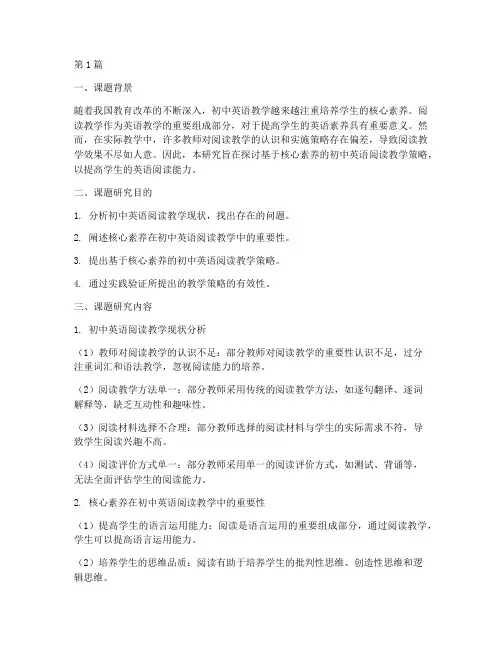
第1篇一、课题背景随着我国教育改革的不断深入,初中英语教学越来越注重培养学生的核心素养。
阅读教学作为英语教学的重要组成部分,对于提高学生的英语素养具有重要意义。
然而,在实际教学中,许多教师对阅读教学的认识和实施策略存在偏差,导致阅读教学效果不尽如人意。
因此,本研究旨在探讨基于核心素养的初中英语阅读教学策略,以提高学生的英语阅读能力。
二、课题研究目的1. 分析初中英语阅读教学现状,找出存在的问题。
2. 阐述核心素养在初中英语阅读教学中的重要性。
3. 提出基于核心素养的初中英语阅读教学策略。
4. 通过实践验证所提出的教学策略的有效性。
三、课题研究内容1. 初中英语阅读教学现状分析(1)教师对阅读教学的认识不足:部分教师对阅读教学的重要性认识不足,过分注重词汇和语法教学,忽视阅读能力的培养。
(2)阅读教学方法单一:部分教师采用传统的阅读教学方法,如逐句翻译、逐词解释等,缺乏互动性和趣味性。
(3)阅读材料选择不合理:部分教师选择的阅读材料与学生的实际需求不符,导致学生阅读兴趣不高。
(4)阅读评价方式单一:部分教师采用单一的阅读评价方式,如测试、背诵等,无法全面评估学生的阅读能力。
2. 核心素养在初中英语阅读教学中的重要性(1)提高学生的语言运用能力:阅读是语言运用的重要组成部分,通过阅读教学,学生可以提高语言运用能力。
(2)培养学生的思维品质:阅读有助于培养学生的批判性思维、创造性思维和逻辑思维。
(3)提升学生的文化素养:阅读可以让学生了解不同文化背景,提升文化素养。
(4)激发学生的学习兴趣:丰富的阅读材料可以激发学生的学习兴趣,提高学习积极性。
3. 基于核心素养的初中英语阅读教学策略(1)激发阅读兴趣:教师可以通过创设情境、设计游戏等方式激发学生的阅读兴趣。
(2)注重阅读策略指导:教师应教授学生阅读策略,如预测、略读、寻读、精读等,提高学生的阅读效率。
(3)选择合适的阅读材料:教师应根据学生的实际需求和兴趣,选择合适的阅读材料。
初中英语教研组小课题(3篇)
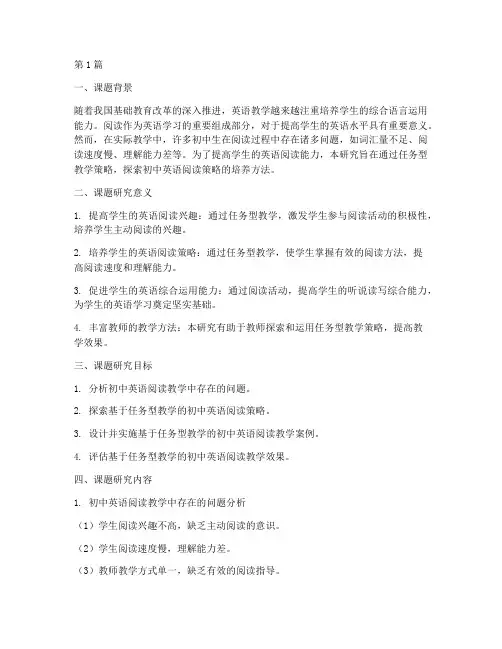
第1篇一、课题背景随着我国基础教育改革的深入推进,英语教学越来越注重培养学生的综合语言运用能力。
阅读作为英语学习的重要组成部分,对于提高学生的英语水平具有重要意义。
然而,在实际教学中,许多初中生在阅读过程中存在诸多问题,如词汇量不足、阅读速度慢、理解能力差等。
为了提高学生的英语阅读能力,本研究旨在通过任务型教学策略,探索初中英语阅读策略的培养方法。
二、课题研究意义1. 提高学生的英语阅读兴趣:通过任务型教学,激发学生参与阅读活动的积极性,培养学生主动阅读的兴趣。
2. 培养学生的英语阅读策略:通过任务型教学,使学生掌握有效的阅读方法,提高阅读速度和理解能力。
3. 促进学生的英语综合运用能力:通过阅读活动,提高学生的听说读写综合能力,为学生的英语学习奠定坚实基础。
4. 丰富教师的教学方法:本研究有助于教师探索和运用任务型教学策略,提高教学效果。
三、课题研究目标1. 分析初中英语阅读教学中存在的问题。
2. 探索基于任务型教学的初中英语阅读策略。
3. 设计并实施基于任务型教学的初中英语阅读教学案例。
4. 评估基于任务型教学的初中英语阅读教学效果。
四、课题研究内容1. 初中英语阅读教学中存在的问题分析(1)学生阅读兴趣不高,缺乏主动阅读的意识。
(2)学生阅读速度慢,理解能力差。
(3)教师教学方式单一,缺乏有效的阅读指导。
(4)缺乏科学的阅读评价体系。
2. 基于任务型教学的初中英语阅读策略探索(1)任务设计:根据学生的阅读水平和教学内容,设计具有针对性的阅读任务。
(2)任务实施:引导学生参与阅读任务,培养学生的阅读能力。
(3)任务评价:对学生的阅读任务完成情况进行评价,调整教学策略。
3. 基于任务型教学的初中英语阅读教学案例设计(1)选材:选取具有代表性的英语阅读材料,如故事、文章等。
(2)任务设计:根据阅读材料的特点,设计相应的阅读任务。
(3)教学过程:引导学生完成阅读任务,培养学生的阅读策略。
4. 基于任务型教学的初中英语阅读教学效果评估(1)学生阅读兴趣和阅读能力的提高。
英语教研课题研初中(3篇)
第1篇Abstract:This research aims to explore effective strategies for improving English teaching and learning in junior high schools. By conducting a comprehensive study, this research will identify the challenges faced by teachers and students, propose innovative teaching methods, and provide practical recommendations for enhancing the overall English language proficiency of junior high school students.Introduction:English has become an essential language in today's globalized world. As junior high school students transition from primary education to secondary education, their English language skills play a crucial rolein their academic and professional development. However, the traditional teaching methods often fail to cater to the diverse needs of students, resulting in a lack of motivation and low achievement levels. This research aims to address these issues by exploring research-based approaches to enhance English teaching and learning in junior high schools.1. Literature Review1.1 Theoretical FrameworkThe research will be based on several theoretical frameworks, including the Communicative Language Teaching (CLT) approach, the constructivist learning theory, and the sociocultural theory of learning. These frameworks will provide a foundation for understanding the complexities of English language teaching and learning in junior high schools.1.2 Existing ResearchA review of existing literature will be conducted to identify the current trends and challenges in English teaching and learning in junior high schools. This review will help identify gaps in the research and guide the development of the research objectives.2. Research Objectives2.1 To identify the challenges faced by teachers and students in English teaching and learning in junior high schools.2.2 To explore innovative teaching methods that can enhance the English language proficiency of junior high school students.2.3 To propose practical recommendations for enhancing the overall English language proficiency of junior high school students.3. Research Methodology3.1 Quantitative ResearchA survey will be conducted to collect data from a sample of junior high school teachers and students. The survey will cover various aspects of English teaching and learning, including the use of technology, classroom management, and student motivation.3.2 Qualitative ResearchIn-depth interviews will be conducted with a select group of teachers and students to gain insights into their experiences and perceptions of English teaching and learning in junior high schools. These interviews will be analyzed using thematic analysis to identify common themes and patterns.4. Results4.1 Challenges Faced by Teachers and StudentsThe research will identify the challenges faced by teachers and students in English teaching and learning. These challenges may include a lack of resources, inadequate training, and the need for a more student-centered approach.4.2 Innovative Teaching MethodsThe research will explore innovative teaching methods that can enhance the English language proficiency of junior high school students. Thesemethods may include project-based learning, flipped classrooms, and gamified learning.4.3 Practical RecommendationsBased on the findings of the research, practical recommendations will be proposed for enhancing the overall English language proficiency ofjunior high school students. These recommendations will focus on teacher training, curriculum development, and the use of technology in the classroom.5. ConclusionThis research will contribute to the field of English language teaching and learning by providing insights into the challenges faced by teachers and students in junior high schools. The proposed strategies and recommendations will help educators develop effective teaching methods that cater to the diverse needs of students. By implementing these research-based approaches, junior high schools can enhance the English language proficiency of their students, preparing them for success in the globalized world.References:1. Brown, H. D. (2007). Principles of language learning and teaching(5th ed.). New York: Pearson.2. Nation, I. (2001). Language curriculum design. Cambridge: Cambridge University Press.3. Nunan, D. (1991). Language teaching methodology: A textbook for teachers. Hertfordshire: Prentice Hall International.4. Richards, J. C., & Rodgers, T. S. (2001). Approaches and methods in language teaching (2nd ed.). Cambridge: Cambridge University Press.5. Swain, M. (1985). Communicative competence: Some roles of comprehensible input and comprehensible output in its development. In G. Cook & B. Seidlhofer (Eds.), Principle and practice in appliedlinguistics (pp. 129-160). Oxford: Oxford University Press.第2篇Abstract:This research study aims to explore and analyze the current state of English language teaching in junior high schools in [Country/City]. The study will focus on identifying effective teaching strategies, challenges faced by teachers and students, and the overall impact of English language education on students' academic and personal development. Through a mixed-methods approach, including surveys, interviews, and classroom observations, this research will provide valuable insights into improving English language teaching practices in junior high schools.Introduction:The importance of English language proficiency cannot be overstated in today's globalized world. As a gateway to international communication, culture, and knowledge, English language education plays a crucial role in the development of students in junior high schools. However, despite the recognition of its significance, there are various challenges faced by teachers and students in the teaching and learning process. This research study aims to address these challenges and propose strategies to enhance English language teaching in junior high schools.1. Background and Significance:1.1 The increasing demand for English proficiency in the global job market.1.2 The importance of English language education in fostering critical thinking and communication skills.1.3 The need to adapt teaching methods to cater to the diverse needs of students.2. Literature Review:2.1 Current trends in English language teaching.2.2 Effective teaching strategies and methodologies.2.3 Challenges faced by teachers and students in junior high schools.2.4 Impact of English language education on students' academic and personal development.3. Research Objectives:3.1 To identify the current state of English language teaching in junior high schools.3.2 To analyze the effectiveness of different teaching strategies and methodologies.3.3 To explore the challenges faced by teachers and students in the English language classroom.3.4 To propose strategies for enhancing English language teaching in junior high schools.4. Research Methodology:4.1 Mixed-methods approach: combining quantitative and qualitative data collection methods.4.2 Surveys: administering questionnaires to teachers and students to gather data on their experiences and perceptions.4.3 Interviews: conducting in-depth interviews with selected teachers and students to gain insights into their experiences and challenges.4.4 Classroom observations: observing English language classes to analyze teaching practices and student engagement.5. Data Analysis:5.1 Quantitative data analysis: using statistical software to analyze survey data.5.2 Qualitative data analysis: employing thematic analysis to identify patterns and themes in interview and observation data.6. Results:6.1 Analysis of survey data: identifying common challenges and strengths in English language teaching.6.2 Analysis of interview data: exploring the personal experiences and insights of teachers and students.6.3 Analysis of classroom observations: evaluating the effectiveness of teaching strategies and student engagement.7. Discussion:7.1 Discussion of the findings, highlighting key trends and challenges.7.2 Comparison of the research findings with existing literature.7.3 Implications for English language teaching in junior high schools.8. Recommendations:8.1 Strategies for enhancing English language teaching, including the integration of technology, flipped classrooms, and project-based learning.8.2 Professional development opportunities for teachers to improve their pedagogical skills.8.3 Support systems for students to overcome learning difficulties and improve their English proficiency.9. Conclusion:This research study provides valuable insights into the current state of English language teaching in junior high schools. By identifying effective teaching strategies and addressing the challenges faced by teachers and students, this study aims to contribute to the improvement of English language education in junior high schools. The findings of this study can be used to inform policy-making, professional development initiatives, and classroom practices.References:[Include a list of relevant academic articles, books, and other resources used in the research study.]Appendices:[Include any additional materials, such as survey questionnaires, interview guides, and observation protocols.]---This outline provides a comprehensive structure for a research study on enhancing English language teaching in junior high schools. The actual content of the research paper would require detailed data collection, analysis, and discussion based on the specific context and findings of the study.第3篇Abstract:This research-based English teaching and research topic aims to explore effective strategies and methodologies to enhance English language learning in junior high schools. The study will focus on identifying the current challenges faced by junior high school students in learning English, analyzing the impact of various teaching methods on student achievement, and proposing practical solutions to improve the overall English proficiency of students. The research will be conducted through a mixed-methods approach, including surveys, interviews, and classroom observations.I. IntroductionThe English language has become an essential tool for global communication and an important part of the curriculum in many countries. Junior high school students are at a critical stage of language development, where their foundational skills in English cansignificantly impact their future academic and professional lives. However, many students face various challenges in learning English, such as lack of motivation, ineffective teaching methods, and insufficient exposure to the language. This research aims to address these issues andpropose practical solutions to improve English language learning in junior high schools.II. Background and Significance2.1 Current Challenges in English Language LearningIn junior high schools, students often encounter several challenges in learning English, including:- Lack of motivation: Many students find English learning monotonous and irrelevant to their daily lives.- Inadequate vocabulary: Students struggle with building a strong vocabulary base, which hinders their ability to express themselves effectively.- Ineffective teaching methods: Traditional teaching approaches may not cater to the diverse learning styles and needs of students.- Insufficient exposure to the language: Limited opportunities for real-life language use can hinder language development.2.2 Significance of the ResearchThe research aims to:- Identify the specific challenges faced by junior high school students in learning English.- Analyze the impact of various teaching methods on student achievement.- Propose practical solutions to improve English language learning outcomes.- Provide insights for English teachers and administrators to develop effective teaching strategies.III. Research MethodologyThis study will adopt a mixed-methods approach, combining quantitative and qualitative data collection methods. The following methods will be used:3.1 SurveysA survey will be designed to gather data from a sample of junior high school students and teachers. The survey will cover aspects such as students' motivation, learning styles, vocabulary knowledge, and their perceptions of the teaching methods used.3.2 InterviewsIn-depth interviews will be conducted with selected English teachers to explore their perspectives on teaching English in junior high schools. The interviews will focus on their experiences, challenges, and strategies for improving student learning outcomes.3.3 Classroom ObservationsClassroom observations will be conducted to assess the effectiveness of different teaching methods and to identify areas for improvement. Observations will be carried out in various classrooms and will include both formative and summative assessments.IV. Results and Discussion4.1 Analysis of Survey DataThe survey data will be analyzed to identify the most common challenges faced by students in learning English. It will also provide insightsinto the effectiveness of current teaching methods and the level of student motivation.4.2 Analysis of Interview DataThe interview data will be thematically analyzed to identify common themes and patterns in teachers' experiences and strategies. This analysis will help in understanding the challenges faced by teachers and the potential solutions to improve English language learning.4.3 Analysis of Classroom ObservationsThe classroom observations will be used to identify effective teaching strategies and areas that require improvement. The findings will be discussed in the context of the overall goal of enhancing English language learning in junior high schools.V. RecommendationsBased on the research findings, the following recommendations will be proposed:5.1 Enhancing Student Motivation- Incorporate real-life contexts and applications of English in various subjects.- Use multimedia resources and technology to make learning more engaging.- Provide opportunities for students to practice English in group activities and projects.5.2 Improving Vocabulary Knowledge- Introduce vocabulary through various activities, such as games, songs, and stories.- Encourage students to use new vocabulary in their daily language use.- Provide regular vocabulary tests and quizzes to reinforce learning.5.3 Adopting Effective Teaching Methods- Implement a variety of teaching methods, such as task-based learning, cooperative learning, and project-based learning.- Personalize instruction to cater to the diverse learning styles and needs of students.- Provide professional development opportunities for teachers to enhance their teaching skills.VI. ConclusionThis research-based English teaching and research topic has explored the challenges faced by junior high school students in learning English and the impact of various teaching methods on student achievement. By proposing practical solutions and recommendations, the study aims to contribute to the improvement of English language learning outcomes in junior high schools. The findings and recommendations can serve as a valuable resource for English teachers, administrators, and policymakers to enhance the quality of English language education in junior high schools.。
2023年初中英语小课题精选9篇
2023年初中英语小课题精选9篇初中英语小课题1一、立题的背景本课题源于英语课堂教学,与我县当前正在开展的中小学教师“高效课堂”研训活动相融合,是“高效课堂”研训的重要组成部分。
英语课堂的导入本身是一门艺术。
魏书生先生也说过:“好的导语像磁铁,一下子能把学生的注意力聚拢起来,好的导语又像是思想的电光石火,能给学生以启迪,催人奋进。
”好的导语是教师打造的第一把钥匙,放射出独特的光芒,带领着学生登堂入室。
目前,农村学生对于英语学习有一定的厌倦情绪,如果在新课导入时不采取一些有效的方法来吸引学生,学生的兴趣就会日益减退,也就很难调动学生的积极性;如果教师总是用老式陈旧,单一乏味的方式来导入新课,导入就失去了应有的作用。
成功的导入依赖导入的多样性和有效性。
每天带给学生点期盼,每天带给学生点惊喜,每天带给学生点不同,每天带学生点启迪。
这样既可以活跃课堂气氛,促进学生参与,还可以引发学生思考,使学生保持学习英语的兴趣和动力。
二、立题的意义我们一线教师是“高效课堂”的践行者,我们必须与时俱进,立足新课程,运用新理念潜心研究课堂教学新方法、新模式,应从课堂教学第一步入手追求各个环节整体高效,我们的课题研究以“高效课堂”目标,以新课程理念为导向,引领我校英语老师探索有效课堂导入理论策略,设计高效导入,指导教学实践,引领我校英语教师专业化发展。
英语课堂教学的导入多种多样,根据不同类型、不同内容的课选择使用不同的导入手段,其目的只有一个:激发学生学习的兴趣,启迪他们的心智,使学生重塑自信,觉得英语课好学、易学,产生兴趣,减少焦虑,达到事半功倍。
因此,我确立研究课题《初中英语课堂导入方法探究》关键词:英语教学、英语课堂导入1.英语教学随着社会的进步,英语已从一种工具变成了一种思想,一种知识库。
在英语课堂教学中,教师尤其要注重学生主体地位的发挥,以让学生积极参与为目的,在英语课堂的教学导入中更能体现这一宗旨。
2. 课堂导入第斯多惠指出:“教学的艺术不在于传授本领,而在于激励、唤醒、鼓舞”。
初中英语教研课题研究(3篇)
第1篇摘要随着我国教育的不断发展,英语作为一门国际通用语言,在初中教育中占有越来越重要的地位。
为了提高初中英语教学质量,本文针对初中英语教研课题进行了研究,旨在通过分析当前初中英语教学现状,探讨有效的教学策略,为初中英语教师提供有益的参考。
一、研究背景1. 英语教育的重要性英语作为一门国际通用语言,对于培养青少年的跨文化交际能力、拓宽国际视野具有重要意义。
在我国,英语教育已成为基础教育的重要组成部分,初中英语教学更是关键阶段。
2. 初中英语教学现状目前,我国初中英语教学存在以下问题:(1)教师教学观念陈旧,教学方法单一,难以激发学生的学习兴趣。
(2)课堂氛围沉闷,学生参与度不高,教学效果不佳。
(3)学生英语基础薄弱,缺乏有效的学习方法。
(4)教师评价体系不完善,难以全面评价学生的学习成果。
二、研究目的1. 分析初中英语教学现状,找出存在的问题。
2. 探讨有效的教学策略,提高初中英语教学质量。
3. 为初中英语教师提供有益的参考,促进教师专业发展。
三、研究内容1. 初中英语教学现状分析(1)教师方面:教学观念陈旧,教学方法单一,缺乏对学生个体差异的关注。
(2)学生方面:英语基础薄弱,缺乏学习兴趣,学习方法不当。
(3)教学环境方面:课堂氛围沉闷,教学资源不足,评价体系不完善。
2. 初中英语教学策略探讨(1)转变教学观念,关注学生个体差异教师应树立以学生为本的教学理念,关注学生的个体差异,因材施教。
在教学中,教师应尊重学生的个性,激发学生的学习兴趣,培养学生的学习能力。
(2)创新教学方法,提高课堂效率教师应运用多种教学方法,如情境教学法、任务型教学法、合作学习法等,提高课堂效率。
同时,教师应注重课堂互动,引导学生积极参与,培养学生的自主学习能力。
(3)优化教学环境,提高教学质量学校应加大投入,改善教学设施,为教师提供良好的教学环境。
教师应充分利用多媒体技术,丰富教学内容,提高教学质量。
(4)完善评价体系,全面评价学生学习成果教师应建立科学、合理的评价体系,全面评价学生的学习成果。
初中英语小专题教研(3篇)
第1篇一、引言随着我国教育改革的不断深入,英语教学作为一门重要的学科,越来越受到人们的关注。
为了提高初中英语教学质量,促进教师专业成长,开展小专题教研活动具有重要意义。
本文将围绕初中英语小专题教研进行探讨,旨在为英语教师提供一些有益的参考。
二、小专题教研的背景与意义1. 背景(1)国家政策要求。
近年来,我国政府高度重视英语教育,明确提出要全面提高国民英语水平。
初中英语作为基础教育阶段的关键课程,其教学质量直接影响着学生的英语素养。
(2)教育改革需求。
新一轮基础教育课程改革对英语教学提出了更高的要求,教师需要不断更新教学观念、改进教学方法,以适应教育改革的需要。
(3)教师专业发展需求。
教师作为教育改革的中坚力量,需要不断提高自身专业素养,以更好地适应教育教学工作。
2. 意义(1)提高英语教学质量。
通过小专题教研,教师可以共同探讨教学中的难点、热点问题,分享教学经验,提高教学水平。
(2)促进教师专业成长。
小专题教研有助于教师拓宽视野,学习先进的教学理念和方法,提升自身专业素养。
(3)加强教师之间的交流与合作。
小专题教研为教师搭建了一个交流平台,有助于教师之间相互学习、共同进步。
三、小专题教研的内容与形式1. 内容(1)教材分析。
教师共同分析教材,探讨教材的编写意图、教学目标、教学重难点等。
(2)教学方法研究。
教师针对具体教学内容,探讨有效的教学方法,如情境教学法、任务型教学法等。
(3)教学评价研究。
教师共同探讨如何进行有效的教学评价,包括学生评价、教师评价等。
(4)教学资源整合。
教师共同研究如何整合教学资源,提高教学效果。
(5)信息技术与英语教学融合。
教师探讨如何将信息技术融入英语教学,提高教学效率。
2. 形式(1)专题讲座。
邀请专家或优秀教师进行专题讲座,分享教学经验。
(2)教学观摩。
组织教师观摩优秀课例,共同分析教学设计、教学方法等。
(3)教学研讨。
教师围绕某一教学主题进行研讨,分享教学心得。
(4)教学实践。
- 1、下载文档前请自行甄别文档内容的完整性,平台不提供额外的编辑、内容补充、找答案等附加服务。
- 2、"仅部分预览"的文档,不可在线预览部分如存在完整性等问题,可反馈申请退款(可完整预览的文档不适用该条件!)。
- 3、如文档侵犯您的权益,请联系客服反馈,我们会尽快为您处理(人工客服工作时间:9:00-18:30)。
初中英语微型课题研究篇一:初中英语小课题研究初中英语小课题研究《初中英语阅读欣赏课》研究(一)在初中开设阅读欣赏课,是贯彻《英语新课程标准》的要求。
基础教育阶段英语课程的任务是:激发和培养学生学习英语的兴趣,使学生树立自信心,养成良好的学习习惯和形成有效的学习策略,发展自主学习的能力和合作精神;使学生掌握一定的英语基础知识和听、说、读、写技能,形成一定的综合语言运用能力;培养学生的观察、记忆、思维、想象能力和创新精神;帮助学生了解世界和中西方文化的差异,拓展视野,培养爱国主义精神,形成健康的人生观、为他们的终生学习和发展打下良好的基础。
阅读,不仅是同学们必须掌握的一种技能,更是他们观察的内容之一,是了解世界和中希望文化差异,拓展视野等的基础手段之一。
在《课程标准》的内容标准中,更是明确规定了三、四、五级的阅读目标,其中有一项就是除教材外,课外阅读量应累计达到4万、10万、15万词以上。
(二)在初中开设阅读欣赏课,符合学生的认知规律。
“熟读唐诗三百首,不会作诗也会吟”。
众所周知,学语言,语言环境是非常重要的一个因素。
有了良好的语言环境,同学们可以在或主动或被动的情况下,去感知语言,进而理性的学习语言,为听、说、写的技能提高奠定基础。
从而才能够在文化意识、情感态度等方面得到提高。
(三)在初中开设阅读欣赏课,顺应素质教育和中、高考改革的需要。
开设阅读欣赏,不仅仅是对阅读能力的培养,也必将促进其他语言应用能力的提高。
同时,在阅读中,也可以获取大量信息,陶冶情操,提高综合素质。
在目前阶段,无论教育怎么改革,中、高考都是一个不可回避的话题。
同样,中、高考也是检验教学效果的一个重要指标。
无论中考还是高考,所有题型首先要面对的就是阅读。
在近年英语中考试卷中,直接考查学生阅读能力题型的权重不断增加。
阅读教学在英语教学中也就愈发重要。
二、专题研究的主要内容和目标。
研究内容:阅读欣赏课的阅读材料的组织、课堂设计以及阅读任务的设置。
研究目标:摸索、建立一套科学、合理、有效的阅读欣赏课模式。
三、专题研究的组织。
英语阅读欣赏主题研究的提出得到了我校领导和全体英语教师的重视和认同,英语教研组全员参与。
明确课题研究必须从实际从发,发扬务实、创新、高效精神,统一思想,加强学习,勇于实践,广泛开展教学研究,最终促进学生语言综合运用的能力,提高英语中考成绩,从而提高英语教学的整体效果。
四、课题研究的指导理论及纲要。
贯彻《英语新课程标准》的基本理念,遵循《课标》的课程目标,参照《课阅读欣赏课题研究分两大块来开展实施:(一)课内。
1. 精读。
2. 阅读理解、完形填空、情景阅读、补全短文等阅读类题型的解题指导。
3. 阅读欣赏课。
(二)课外。
1. 在学校橱窗开辟英语专栏。
2. 在教室黑板报中设立《英语角》专栏。
3. 鼓励学生订阅《英语周报》的英语类报纸杂志。
4. 开展学生自编英语小报活动。
在上列实施活动中,我校研究的重点放在如何开英语阅读欣赏课上。
英语阅读欣赏课研究的过程:(一)初识阅读欣赏课。
在接触这个课题之初,我们去兄弟学校听了一节阅读欣赏的研究课。
教者挑选了五篇短文。
在课上,教者显示呈现了一篇短文,然后让同学们通过阅读完成一些教者设计的问题。
然后呈现第二篇短文,这样,用同样的程序完成五篇短文。
只是每篇短文后所设计的题型有所不同,或是回答问题,或是判断正误,或是选择。
在完成了所有短文的任务后,教者进行了总结,归纳出一些阅读技巧。
听完这节课后,我们对这节课进行了讨论。
本节课虽然是围绕阅读来进行的。
但总的感觉更象是一节阅读理解解题技巧讲解课。
通过听课和讨论,我们对阅读欣赏课有了初步的认识:1. 阅读欣赏课应该与阅读理解讲解课有所区别。
既然是阅读欣赏课,就要能在阅读中欣赏,在欣赏中阅读。
所以这个课型的名称就决定了它在形式、内容、方法上要与阅读理解技巧讲解不同。
它不应该是技巧的讲解,而是通过阅读和任务设计,在阅读与欣赏中掌握技巧,运用技巧在欣赏中阅读。
2. 阅读欣赏课整节课应该是一个有机的整体。
一节阅读欣赏课,应该有一定的容量。
那自然应该是好几篇短文。
但是教者需要通过认真的思考和分析,合理设计,使整节课成为一个有机的整体。
如果就是那么读一篇,讲一篇,再读一篇,再讲一篇,那么就会给学生一种为阅读而阅读的感觉,整节课也就显得比较零散。
(二)初试阅读欣赏课。
有了基本的看法和认识,我们开始了阅读欣赏课的初步尝试。
这次,我们需要面对的材料依然是五篇短文。
字数为1000词左右,面对的是八年级的同学。
五篇短文内容如下:ASam likes eating fish very much. He often buys fish in the shop and takes them home. One day his wife (妻子) sees the fish and think s, “Good! Now, I can ask my friends to have lunch and we can eat the fish. They like fish very much. ”When Sam es home from work in the evening, the fish is not there and his wife says, “Oh, your cat eats it.” And then she gives him some bread for his supper. Sam is angry(生气). He takes the cat and his wife to a shop near his house and weighs(称)the cat. Then he turns to his wife and says, “My fish weighs one kilo. The cat weighs one kilo, too. My cat is here, you see, then, where is my fish? ”BMark Twain was asked one day if he could remember the first money he ever earned .He thought a long time before answering, and then said , “Yes, it was at school , I can remember everything about it. Schoolboys (来自: 小龙文档网:初中英语微型课题研究)in those days didn’t respect their teachers and didn’t take good care of their desks and chairs. They often used knives to cut words or something on them. But if they did so , they would be beaten in front of the whole school, or would have to pay five dollars to the school.”“One day I d id such a thing and I had to ask myfather what to choose----to be beaten or to pay five dollars. My father said it would be too bad to lose face in front of the whole school, so he decided to give me five dollars to hand over to the teacher. But before giving me the money ,he took me to his room and gave me a good beating. But as I had one beating and got used to it. I decided I would take another beating at school and keep the five dollars. So that was the first money I ever earned.”CThe koala is an Australian animal. It has gray and brown fur(毛皮). And the fur on its belly(腹部) is white. Koalas eat, sleep in eucalyptus trees(桉树). They almost never get down the trees. They are active(活跃的) at night and sleep during the day.People often think that koalas are friendly animals because they look very cute. But they may scratch(乱抓) people if they are not happy. They have sharp claws(利爪). So please be friendly to them. In the past(过去), koalas were often hunted(猎获) because of their beautiful, soft and thick(软而厚实) fur. Now they area protected species(保护动物) and it's illegal(非法的) to hunt them. We need koalas and other animals, they are our dear friends!DDogs are friends of man. They work for us. They hunt with us. They also play with us. But a long time ago, all over the world, dogs were wild. Dogs can go backto the Stone Age. All dogs had the same ancestor (祖先). It is believed that this ancestor was much like a wolf. Other animals, like fox, also came from this ancestor. Thousands of years ago, man began to tame (使驯服) the wild dogs. When the dogs were tamed, they were trained (训练) well. The strong dogs then became working animals. They were trained to pull heavy loads (担子). They learned to keep watching over sheep and other animals. Working dogs could do other things, too. Some dogs were not strong. But they could help man hunt. Other dogs were best at pets. At first, there were only a few kinds of dogs. Today, there are more than 100 kinds.EBill Gates was born on October 28, 1955. He grew up in Seattle, Washington. Bill Gates was named William Hey after his father and grandfather. He was a very clever boy. His favorite subjects at school were science and math. When people asked him what he wanted to be in the future, he always said, “A scientist.”When he was 13 years old, Bill started to play with puters. At that time, puters were very large machines. Once he was interested in a very old puter. He and some of his friends spent lots of time doing unusual things with it. In the end, they worked out a software program with the old machine. Bill sold it for 4,200 dollars when he was only 17.In 1973, Bill went to Harvard University. At Harvard, he developed the BASIC language for the first microputer. In his third year, he left Harvard to work for a pany called Microsoft. Bill began this pany in 1975 with his friend Paul Allen. They thought that the puter would be a very important tool(工具)in every office and in every home, so they began developing software for personal puters. They improved the software to make it easier for people to use puters.In 1999, Bill wrote a book called Business @ the Speed of Thought. In the book he told people how puter technology could solve business problems in new ways. It was one on the best-sellers of the New York Times list.按照我们对阅读欣赏课的理解,首先要做的第一件事情,就是要把五篇独立的小短文有机的联系在一起,各篇章之间过渡要自然。
